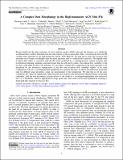Files in this item
A complex dust morphology in the high-luminosity AGN Mrk 876
Item metadata
| dc.contributor.author | Landt, Hermine | |
| dc.contributor.author | Mitchell, Jake A. J. | |
| dc.contributor.author | Ward, Martin J. | |
| dc.contributor.author | Mercatoris, Paul | |
| dc.contributor.author | Pott, Jörg-Uwe | |
| dc.contributor.author | Horne, Keith | |
| dc.contributor.author | Hernández Santisteban, Juan V. | |
| dc.contributor.author | Malhotra, Daksh | |
| dc.contributor.author | Cackett, Edward M. | |
| dc.contributor.author | Goad, Michael R. | |
| dc.contributor.author | Romero Colmenero, Encarni | |
| dc.contributor.author | Winkler, Hartmut | |
| dc.date.accessioned | 2023-03-08T11:30:08Z | |
| dc.date.available | 2023-03-08T11:30:08Z | |
| dc.date.issued | 2023-03-07 | |
| dc.identifier | 283657897 | |
| dc.identifier | f1c3149f-2457-4a62-806e-460bb4d1d289 | |
| dc.identifier | 85149892823 | |
| dc.identifier.citation | Landt , H , Mitchell , J A J , Ward , M J , Mercatoris , P , Pott , J-U , Horne , K , Hernández Santisteban , J V , Malhotra , D , Cackett , E M , Goad , M R , Romero Colmenero , E & Winkler , H 2023 , ' A complex dust morphology in the high-luminosity AGN Mrk 876 ' , Astrophysical Journal , vol. 945 , 62 . https://doi.org/10.3847/1538-4357/acb92d | en |
| dc.identifier.issn | 0004-637X | |
| dc.identifier.other | Jisc: 943713 | |
| dc.identifier.other | publisher-id: apjacb92d | |
| dc.identifier.other | manuscript: acb92d | |
| dc.identifier.other | other: aas43933 | |
| dc.identifier.other | ORCID: /0000-0002-6733-5556/work/130660135 | |
| dc.identifier.uri | https://hdl.handle.net/10023/27126 | |
| dc.description | Funding: H.L. acknowledges a Daphne Jackson Fellowship, sponsored by the Science and Technology Facilities Council (STFC), UK. J.A.J.M. acknowledges the support of STFC studentship ST/S50536/1. H.L., J.A.J.M., and M.J.W. acknowledge support from STFC grants ST/P000541/1 and ST/T000244/1. K.H. and J.V.H.S. acknowledge support from STFC grant ST/R000824/1. E.R.C. acknowledges the support of the South African National Research Foundation. | en |
| dc.description.abstract | Recent models for the inner structures of active galactic nuclei (AGNs) advocate the presence of a radiatively accelerated dusty outflow launched from the outer regions of the accretion disk. Here, we present the first near-IR variable (rms) spectrum for the high-luminosity nearby AGN Mrk 876. We find that it tracks the accretion disk spectrum out to longer wavelengths than the mean spectrum, due to a reduced dust emission. The implied outer accretion disk radius is consistent with the IR results predicted by a contemporaneous optical accretion disk reverberation mapping campaign, and much larger than the self-gravity radius. The reduced flux variability of the hot dust could either be due to the presence of a secondary constant dust component in the mean spectrum or be introduced by the destructive superposition of the dust and accretion disk variability signals, or be some combination of the two. Assuming thermal equilibrium for optically thin dust, we derive the luminosity-based dust radii for different grain properties, using our measurement of the temperature. We find that in all the cases considered, the values are significantly larger than the dust response time measured by IR photometric monitoring campaigns, with the least discrepancy present relative to the result for a wavelength-independent dust emissivity law, i.e., a blackbody, which is appropriate for large grain sizes. This result can be well explained by assuming a flared disk-like structure for the hot dust. | |
| dc.format.extent | 13 | |
| dc.format.extent | 1253252 | |
| dc.language.iso | eng | |
| dc.relation.ispartof | Astrophysical Journal | en |
| dc.subject | QB Astronomy | en |
| dc.subject | NDAS | en |
| dc.subject | MCC | en |
| dc.subject.lcc | QB | en |
| dc.title | A complex dust morphology in the high-luminosity AGN Mrk 876 | en |
| dc.type | Journal article | en |
| dc.contributor.institution | University of St Andrews. School of Physics and Astronomy | en |
| dc.contributor.institution | University of St Andrews. St Andrews Centre for Exoplanet Science | en |
| dc.identifier.doi | 10.3847/1538-4357/acb92d | |
| dc.description.status | Peer reviewed | en |
This item appears in the following Collection(s)
Items in the St Andrews Research Repository are protected by copyright, with all rights reserved, unless otherwise indicated.

